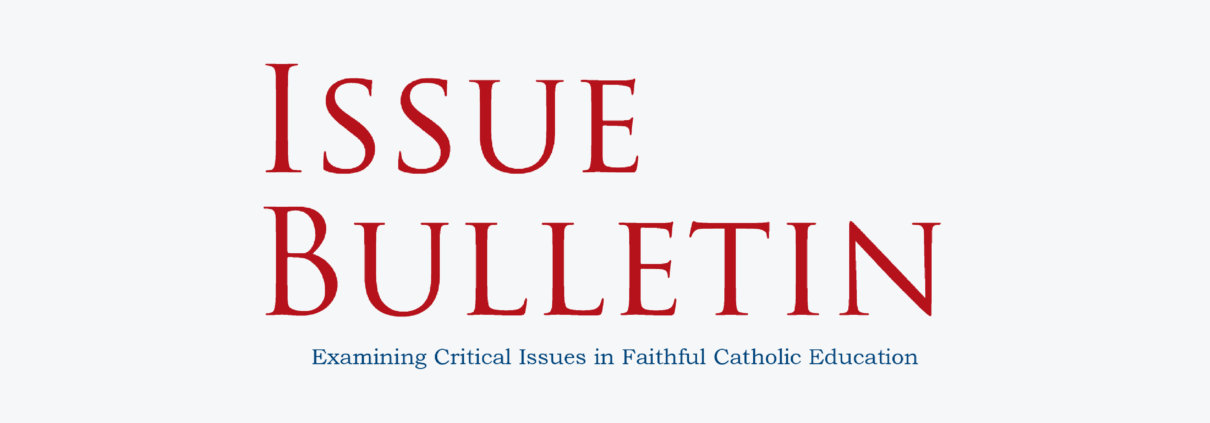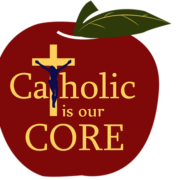10 Critically Important Adaptations to the Common Core for Catholic Schools*
This publication is part of a series of reports on the Common Core State Standards Initiative and how those standards potentially impact Catholic education.
As of yet, there has been no serious effort to analyze the impact of the Common Core State Standards (CCSS)1 on Catholic education—one that engages Catholic school educators at all levels as well as parents, the primary educators of their children. In view of the current environment, it would seem reasonable for those in leadership positions in Catholic education to pause, reflect and plan prior to moving forward with either adopting or adapting the CCSS.
But in the complex environment of operating a Catholic school system, there may be instances where, for whatever reason, a Catholic School has decided to implement the Common Core State Standards. These schools claim that they are not entirely assimilating the troubled and controversial public school standards, but rather “adapting” the standards by changing them to fit with their Catholic mission and pursuit of academic excellence.
While such an attempt (sincerely implemented) is a step above merely copying the public school system, it does not address the fundamental conflict associated with the integral formation of students. Since standards drive curriculum, a Catholic curriculum must include standards that are integrated with the magisterial teachings of the Catholic Church.
For example, consider that Catholics have much to say about literature, history, science, and, above all, about Truth, goodness, and beauty. And, since the object of every academic disci- pline is truth, the Catholic curriculum should be based on the conviction that all truths ultimately converge in their source—God. This standard, among others, is sorely lacking in the Common Core.
If a Catholic school or school system chooses to take the more problematic road of adapting the Common Core Standards (as opposed to creating their own standards), the Catholic school system would greatly benefit from a public discussion (or basic research) about how—if at all—Catholic schools are actually changing the Common Core. Additionally, parents should ask their Catholic school officials what elements of the Common Core (if any) they have found necessary to change/adapt.
As yet, there has not been a significant study or public discussion as to what possible changes Catholic schools might be making in voluntarily implementing the Common Core in our schools. I would like to take the initiative to begin this discussion by enumerating ten important changes to consider.
1. Renounce the English Language Arts (ELA) Percentages for Literary and Informational Texts (which are not research-based).2
- Do not alter your literature selections based on the standards. Stick with the best literature from recognized masters. Use great works with compelling themes that speak to the heart of the human condition across the ages. Do not remove poetry, drama or literature; conversely, do not artificially add more informational texts into your ELA program.
- Throw out the Common Core Appendices. These claim to provide examples and recommended texts. Stick to your tried and true curriculum as much as possible if using Common Core Standards.
2. Reduce textbook use when possible.3
- Move to actual documents and unadapted works. Middle and high school students should not use mass-produced anthologies. Give them the actual texts. This allows them to mark up the texts and keep them on their library shelves at home for future reference or re-reading. Also, a “between-the-covers book” slows down instruction and respects the dignity of the work. It allows the students to feel that they are getting the “real deal” and not an excerpt or adapted exposure to the brightest and most creative minds. Even if they do not read the entire work, students now have access to it.
- Set your teachers and students free with authentic, un-sanitized texts and original questions and assignments. Because the Common Core allows for generic national lessons and lesson plans on topics presented in textbooks, there is a risk of homogenization and standardization, which runs contrary to human diversity and exploration.
3. Respond to the texts, not the Standards.
- Do not use the Common Core Standards as the primary guide for inquiry into litera- ture. The Standards attempt to dissect literature into a set of measurable skills or generic questions.4 However, literary study should not be stuffed into a pre-determined standard or examined with canned questions, which do not directly emanate from the experience of reading a particular work. Literature needs to be unleashed and encountered “as litera- ture”—the product of a creative mind in dialogue with the reader in exploring the human condition. Treating literature simply as grist for the mill of college and career readiness saps its transformative power of inquiry and translation of experience. Yes, there are some relevant skills that the discipline of literary study requires, and the Common Core identifies some of these; however, development of these skills/tools should not become the goal of reading great works.
- Stay away from canned materials and exemplar units. The best teaching is creative, adaptive and natural, as the teacher and students explore the wonders of reality together with joy, passion and excitement. Keep your teachers and instruction creative. Exemplar units and straight textbook “canned” instruction are fine for the teacher to consult so as to get an idea of how effective lessons and units can unfold; just make sure that they do not become the basis of your regular lessons. Some teachers may try to ensure test score suc- cess by not straying from the approved lessons, but authentic learning is often messy and organic—and risky. Beware that computer-based instruction can also be overly scripted and become a crutch and distraction.
4. Do not take the Common Core’s rightful emphasis on text-based arguments too far.
- Do not follow the Common Core’s philosophy that the only way that a student can demonstrate knowledge gleaned from a text is using evidence from the text to support their claim. While careful textual citations of evidence is key, the Standards say that “student knowledge drawn from the text is demonstrated when the student uses evidence from the text to support the claim about the text. Hence, evidence and knowledge link directly to the text.” However, in Catholic schools, knowledge is attained and demonstrated when the human intellect, informed by the senses, judges things rightly. Our criteria include not only the text itself but also a rich and wonderful world outside the text (which the text might brilliantly unveil—sometimes with life-changing effect). Evidence and knowledge are certainly based on the text; however, they are ultimately grounded in truth, beauty and goodness. If we miss this, we miss everything about Catholic education.
- Allow discussion about outside texts or ideas. Do not discourage middle and high school students from also making extensive references to other works; historical, philosophical and religious trends; or their “gut responses.” Do, however, be sure to require rigorous scrutiny of their positions and gut responses and link those back to explicit under- standings and assumptions about the world as well as the topic under exploration. Teach them to unpack their responses in clarity and truth—not to suppress them so as to simply stick to the world of the text or increase standardized test scores.
- Conduct a little test preparation. Teach older students how to sanitize their normal “human” responses for the purposes of the standardized test evaluation.
5. Avoid premature use of technology, peer-editing, research and rhetorical pedagogy in place of good old-fashioned writing instruction.
- Use pencil and paper when you teach writing to young children. Technology is only a teaching tool, not a magic smart pill. Using technology to write can wait. Do not panic that your elementary students will be “left behind” if you are still teaching them to handwrite. None of us over 40 had computers in school, but we have managed somehow to be smart, productive, technologically proficient 21st century learners. Technology is the easy part; thinking clearly and deeply is the hard part, and this can happen without extensive technology. We don’t know what type of technology our students will have at their disposal in 15 years, but we do know what type of brains they will have; we need to prepare those brains for maximum clarity and facility of thought.
- Avoid the early emphasis on peer-editing (a teaching technique and not a standard) and the too early emphasis on research. The Common Core requires peer input and writing using a computer in 1st grade, and “research” with technology in 3rd grade. Younger children may not be ready to evaluate, process and synthesize another ’s work and insights and should focus on their own thinking and writing. It is easy to find out (or copy/plagiarize) what others think; it is harder to clarify your own thinking and find your own voice. Young students deserve adult guidance at this stage and not the faux guidance of their peers who cannot teach what they do not yet know.
- Remember that the goal of writing is to communicate the truth. Writing should not be viewed simply through the Common Core lens of effective rhetoric, where students learn how to manipulate words and use standard grammar to produce a cogent, if not somewhat detached, argument.5 Writing should fundamentally be at the service of truth, beauty and goodness, and it should assist the student to articulate his or her understandings or insights based on penetration into reality. Naturally, since it is also a social activity, writ- ing should follow conventions of grammar and reason in service of the truth and effective communication. In sum, writing is ordered toward an explanation of one’s encounter with truth, goodness and beauty, but it can still attend to some of the Common Core’s skill- based focus.
6. Create your own explicit standards for your junior high and high school literature classes.
- List the critical texts, time periods, authors and genres that you expect your students to cover. The Common Core Standards only chunk and repeat the same empty skills year after year. While this provides some generic guidance, it does not account for adequate content coverage or skills development necessary for effective high school literature.
7. Do not alter your math progression.
- Keep mastery of the standard algorithms using multi-digits at the levels they are currently found. Do not delay these for a year as suggested by the CCSS. Keep addition/ subtraction in 2nd-3rd grade, multiplication in 4th, division in 5th.
- Keep Algebra in 8th grade as the norm for your school. A non-algebra track for struggling students can also be offered for those who fall short of the norm.
- Keep your geometry program unchanged. Do not follow the unorthodox and failed version presented in the Common Core.
- Develop explicit standards for classes necessary for future science, technology, engineering or math (STEM) majors. There currently are no explicit standards for classes such as pre-calculus, trigonometry, statistics, number theory, calculus, etc.
8. Avoid the temptation to push “higher-ordered thinking skills” too quickly.
- Give novices (that is, grade school students) the direct instruction that they need. Be extremely wary of Common Core “inspired” instruction that over-emphasizes or pushes higher-order thinking skills too far down into the younger grades, especially in math. This causes an unnecessary sense of confusion or failure, which can lead to frustration and dis- taste for math at an early age. Experts are the ones who benefit more from a constructivist/exploration-based environment, and properly educated high school students are typically entering this “expert” level of mathematical reasoning. Hours lost in prematurely forcing younger kids into expert/abstract thinking not only leads to frustration and a loss of confidence, but also it comes at the cost of exposure to necessary basics that they will need to become authentic experts in the future.
- Continue to emphasize memorization in the younger grades. This is the raw material upon which abstract reasoning will draw, as their intellects naturally and gradually mature and bloom.
9. Avoid teaching to the tests.
- Focus on good instruction, not this or that test. This is your competitive advantage in a Common Core test crazy environment. Enjoy having more time and freedom to teach; your students will flourish more in the long run. Catholic schools know this from years of experience with not getting trapped into incessant state testing. Authentic tests will expose authentic learning: good instruction trumps unnecessary testing.
- Do still give norm-referenced tests with post-Common Core validity such as the Iowa’s to assist with student formation.
- Do plan for SAT/ACT testing courses to be formally placed in your high school curriculum. Teach students in a discreet course “how” to take a standardized test and respond to prompts in a Common Core expected manner.
10. Keep the greatest distance possible between your curriculum and the Common Core Standards.
- Do not cheerlead for the Common Core. If you are using the standards, that is one thing; there are many usable parts. However, there are also many deep problems with them (perhaps as with any set of standards). When parts fail or weaknesses become evident, you do not want to be married to them.
- Do not praise the Common Core: Let it sink or stand on its own without your prior validation. The Common Core Standards are untested. They claim to be more rigorous and focused than many state standards, but that claim is up for debate. What is not up for debate is the fact that states with “rigorous and focused” standards do not have higher test scores than states judged to have poor standards. There is no correlation between state standards and test scores, as strange as that seems.
- If you use the Standards, set them as sub-floor but not as a foundation for your Catholic education. The Common Core Standards can possibly be a partial and lower (but not critical) part of your larger more lofty efforts at complete human formation. Our foundation must always be Jesus Christ.
- Interpret the Standards as loosely and broadly as possible. Do not attempt to tie daily instruction and lesson plans directly to the Common Core Standards as is required in many public schools. Nevertheless, it is possible with creativity and a healthy skepticism of the philosophies animating the Common Core Standards to give many of them a distant nod. This means essentially saying, “Well yes, when I glance at the Common Core Standards every now and then, I can point to places somewhere not too far from our grade level curriculum where we pretty much do something like that.” In other words, this approach entails not being faithful to the intent and explicit wording of the Common Core, but just acknowledging them close enough to get by.
- Normally such behavior is witnessed when conscientious objectors face the tyranny of an unjust law or authority, and this is better than faithfully instituting the flawed Common Core program; but again, why would Catholic schools, who are not required to teach to the Common Core, select this less than ideal approach?
- We do after all owe it to the world to witness to the Truth about authentic education and about the human person. We also owe a duty to the majority of Catholic children who at- tended public schools to voice our opposition to the flawed program to which they are being subjected. Some public school supporters of the Common Core point to our schools and say, “See, if the Catholic schools are using it, it must be good!”
With so many concerns, one wonders why Catholic schools would base their efforts on the Common Core at all. Catholic schools have had unparalleled and enviable success for decades using their own standards.
I am concerned that many Catholic schools may have jumped on the Common Core band- wagon too early. After all, the Standards have not had adequate opportunity to be vetted; no “body” of Catholic scholars or educators—especially the parents, the primary educators—has thoroughly explored or discussed them. There is no harm in hitting the pause button and continuing the conversation, as we watch the untested Common Core Standards unfold in the public school arena.
Regardless, as some Catholic schools choose to adapt the Common Core, it would benefit us all to discuss openly what is being adapted and why. As with any initial conversation, these remarks and ideas cry out for correction and expansion. I look forward to the conversation.
* The title has changes from the original, “10 Minimal Adaptations Catholic Schools Consider Making to the Common Core State Standards”
- http://www.corestandards.org.
- See http://napcis.org/2013/10/15/the-naked-and-procrustean-common-core-2.
- An extended examination of this topic is well executed in Dr. Terrence Moore’s new book, The Story-Killers, Lexington, KY.
- This point will be familiar to Crisis readers who have seen Anthony Esolen’s work published online here: http://www.crisismagazine.com/2014/how-common-core-devalues-great-literature.
- Another point well made by Dr. Esolen at http://www.crisismagazine.com/2013/common-cores-substandard-writing-standards.



 St. Agnes School, St. Paul, MN
St. Agnes School, St. Paul, MN 


